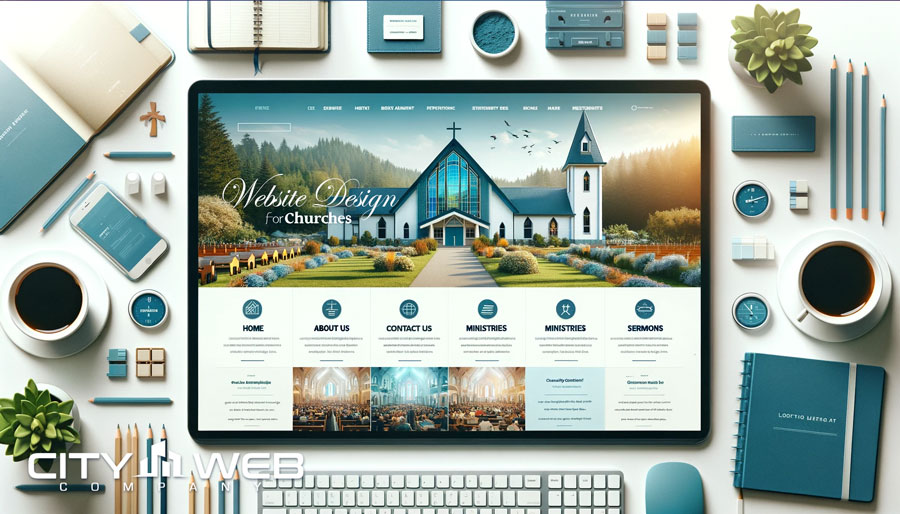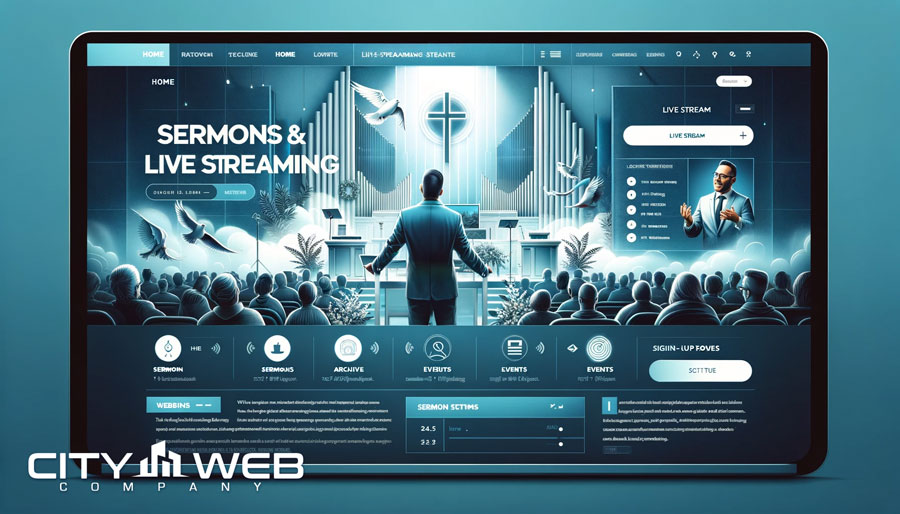Best Web Design Grand Junction: Expert Tips Navigating the web design landscape in Grand Junction…

Best Website Design for Churches: Engage Your Congregation
Table of Contents
Best Website Design for Churches: Engage Your Congregation
Is your church’s digital presence resonating with the spirit of your community?
Imagine a stained glass window. Each colorful piece alone is distinct, yet together they form a powerful, cohesive narrative that captures the eye and the heart. In the digital age, a church’s website should mirror this mosaic—distinct elements seamlessly interwoven to create a compelling, inclusive experience that speaks to both the congregation and the seeker.
Key Points on the Best Website Design for Churches:
- Importance of a well-designed church website
- Elements to consider in church website design
- Popular design trends for church websites
- Optimization tips for search engines
- Considerations for designing the website yourself or hiring a professional
- Well-designed church websites attract and engage with the congregation.
- Key elements include intuitive navigation, responsive design, engaging content, and integration with social media.
- Popular design trends include minimalistic layouts, bold typography, vibrant colors, video backgrounds, and interactive elements.
- Optimize your website with relevant keywords, optimized page titles and meta descriptions, unique URLs, and fresh content.
- Consider whether to design the website yourself or hire a professional for a more polished and effective result.
How can a church website effectively convey its mission and values through design?
A church website plays a crucial role in effectively communicating its mission and values to the audience. The design of the website serves as a powerful tool to convey the essence and identity of the church. Here are some key elements to consider when designing a church website to effectively convey its mission and values:
- Clear and cohesive branding: The design should align with the church’s branding guidelines, including the logo, colors, and typography. This consistency helps establish a sense of identity and recognition, reinforcing the mission and values in the minds of visitors.
- Intuitive navigation: Visitors should be able to easily navigate through the website and find the information they are looking for. Use clear headings, menus, and a logical site structure to make it effortless for users to explore different aspects of the church’s mission and values.
- Compelling imagery: Choose high-quality images that reflect the spirit and diversity of the church community. Showcasing photographs of church events, worship services, and community initiatives can create an emotional connection with visitors, making it easier for them to grasp the mission and values.
- Informative and engaging content: The content on the website should be concise, yet informative. Clearly articulate the church’s mission statement, core values, and beliefs. Include engaging stories, testimonials, and personal experiences that highlight how the mission and values are put into action within the community.
- Highlight key programs and initiatives: Feature the church’s various programs, such as youth ministry, outreach activities, and worship services, prominently on the website. Clearly explain how these programs align with the mission and values, showcasing the impact they have on the community.
- Mobile-friendly design: Ensure that the website is optimized for mobile devices since many visitors access the internet primarily through their smartphones. A responsive design that adapts to different screen sizes will enhance the user experience and make the mission and values easily accessible on any device.
- Call-to-action: Encourage visitors to actively engage with the church by including clear calls-to-action throughout the website. This could be signing up for a newsletter, attending an event, or joining a small group. By facilitating involvement and participation, the website can effectively convey the mission and values in action.
- Accessible design: Make sure the website is accessible to all users, including those with disabilities. Adhering to web accessibility standards not only ensures inclusivity but also demonstrates the church’s commitment to welcoming and valuing every individual.
Embracing Visual Storytelling
Effective church websites leverage the power of visual storytelling to evoke emotion and convey messages in an impactful way. Through carefully curated images, videos, and icons, these sites bring to life the core values and missions that are central to the church’s identity. This visual narrative should resonate deeply, creating an immediate, emotional connection with the viewer, much like the effect of a meaningful sermon or a poignant piece of music.
In integrating visual storytelling, it is fundamental to showcase authenticity and purpose. By featuring real-life photos from community events, serene video clips of worship, or interactive elements that reflect congregational life, a website becomes more than a space for information—it transforms into a digital sanctuary where stories of faith and fellowship can be shared. This narrative approach helps cement the church’s role as a beacon of hope and a conduit for inspiration in the digital realm.
Our partner company WP Commander specializes in maintaining your WordPress website for one low monthly price.
Contact City Web Company or visit: WP Commander to learn more how we'll give your website the white-glove treatment!

Engaging Imagery that Reflects Community
Visuals are the essence of communication—powerful connectors that weave the narrative of your church’s unique community life.
A picture isn’t just worth a thousand words, it’s a window to the soul of your congregation, rendering the invisible heart of your community visible.
Using authentic photographs in your design can convey vibrancy, diversity, and the spirit of your congregation, amplifying the message of unity and engagement through every pixel.
Engaging imagery does more than just decorate—it melds storytelling with a sense of place and purpose, creating an inviting atmosphere that beckons the viewer into a deeper exploration of your community.
What are the key features to consider when designing a website for a church?
When designing a website for a church, there are several key features to consider that will help create a welcoming and engaging online presence for the congregation. Here are some important aspects to keep in mind:
- Clear navigation: A church website should have a user-friendly navigation menu that makes it easy for visitors to find information about services, events, ministries, and contact details. Clear and intuitive navigation will enhance the overall user experience and ensure that important content is easily accessible.
- Responsive design: It is crucial to design a website that is mobile-friendly and responsive. With the increasing use of smartphones and tablets, many people access websites on smaller screens. A responsive design will automatically adjust the layout and content to fit different screen sizes, ensuring a consistent and enjoyable experience for all users.
- Events and calendar: A church is often a hub of various activities and events. Including an events calendar on the website is essential to keep the congregation informed about upcoming services, gatherings, classes, and community outreach programs. The calendar should be easily updatable and allow users to view details, RSVP, and share events on social media.
- Sermon archives: Recording and sharing sermons is a vital part of many churches’ ministries. Including a sermon archive on the website allows visitors to catch up on past sermons, listen to or download them, and further engage with the spiritual teachings. Ideally, the archive should be searchable, categorized, and easily navigable to accommodate different preferences and interests.
- Online donations: Providing a secure and convenient way for church members and supporters to make online donations is crucial for financial sustainability. Integrating an online donation platform on the website, along with clear instructions and different giving options, will make it easy for users to contribute and support the church’s mission.
- Social media integration: Social media platforms provide an excellent opportunity to connect and engage with the church community and reach a wider audience. Integrating social media buttons or feeds into the website allows visitors to easily follow and share content on platforms like Facebook, Instagram, Twitter, or YouTube. This integration helps to extend the reach of the church’s message beyond the website itself.
- Engaging multimedia: Incorporating multimedia elements into the website can enhance the overall user experience. This may include high-quality images, videos, or audio recordings of worship services, events, or community initiatives. Engaging multimedia content can help create a more immersive and captivating online experience for visitors.
- Strong visual identity: A church website should reflect the unique identity and values of the congregation. It is important to establish a strong visual identity that aligns with the church’s brand. This can be achieved through consistent use of colors, fonts, and imagery that evoke the atmosphere and spirit of the community.
What are the important elements to include in the navigation menu of a church website?
When designing the navigation menu for a church website, there are several important elements that you should include to enhance user experience and make it easy for visitors to find the information they need. Here are some key elements to consider:
- Home: The “Home” button should always be included in the navigation menu. It serves as a quick way for users to return to the main page of the website.
- About Us: This section provides information about the church, its mission, history, and values. Including an “About Us” link in the navigation menu gives visitors a clear introduction to the church and its background.
- Worship Services: This section highlights the different worship services offered by the church. It should include details about service times, styles, and any additional information visitors may need to know.
- Ministries: Include a “Ministries” link in the navigation menu to showcase the various programs and ministries offered by the church. This can include children’s ministries, youth groups, women’s or men’s groups, and any other specific ministries the church has in place.
- Sermons: Many visitors come to a church website to access past sermons or listen to live sermons. Including a “Sermons” section in the navigation menu makes it easy for users to find and access these resources.
- Events: This section should highlight upcoming events, such as special services, conferences, community outreach programs, or social events. Including an “Events” link in the navigation menu keeps visitors updated on what’s happening in the church community.
- Contact: A “Contact” link is crucial for visitors who have questions, want to get in touch with church staff, or need information about location and contact details. Make sure to include a contact form or relevant contact information, such as phone number and email address.
- Donate: For churches that rely on donations, including a “Donate” button in the navigation menu provides a convenient way for visitors to contribute financially to the church’s mission and initiatives. Remember, simplicity is key when designing a navigation menu. Avoid overwhelming visitors with too many options and use clear and concise labels for each menu item. By including these important elements in the navigation menu, you can ensure that visitors can easily navigate your church website and find the information they are seeking.
Intuitive Layouts for Improved Navigation
Intuitive navigation is the cornerstone of a user-friendly website, guiding visitors effortlessly through various sections and content. It drives engagement and prevents frustration, solidifying a positive digital experience.
Menus and links must be clear and consistent across all pages to avoid confusion.
An effective layout employs a hierarchical structure, allowing quick access to the most important information without overwhelming the visitor. Drop-down menus, search bars, and well-organized pages are instrumental in achieving this balance.
For your church’s website, intuitive navigation implies creating a structure that mirrors the organizational values and priorities, offering easy access to worship schedules, events, and sermons, while also providing pathways to deeper content such as doctrinal beliefs, volunteer opportunities, and community initiatives. In essence, it should be as welcoming and orderly as the church itself, extending an open invitation to explore and connect within the digital space.
What are the key features to consider when designing a website for a church?
When designing a website for a church, there are several key features that should be considered to ensure an optimal user experience and effective communication with the congregation.
1. Clear Navigation: A well-organized and intuitive navigation menu is essential. It should allow visitors to easily find important information such as service times, location, events, and ministries.
2. Engaging Visuals: Incorporating high-quality images and videos can help create an emotional connection with visitors and showcase the church’s atmosphere, community, and mission.
3. Mobile Responsiveness: With the increasing use of mobile devices, it is crucial for the website to be fully responsive and accessible on different screen sizes. This ensures that individuals can access the site and its content conveniently from any device.
4. Sermon Archives: Providing an easily accessible archive of past sermons enables members and visitors to catch up on missed sermons or revisit ones that resonated with them. This can be done through audio, video, or transcripts.
5. Event Calendar: A dynamic and regularly updated event calendar helps inform the congregation about upcoming activities, including worship services, Bible studies, community events, and volunteer opportunities.
6. Online Giving: Including a secure and user-friendly online giving platform allows members to conveniently contribute financially to the church’s mission. It is essential to ensure a seamless payment process and provide detailed instructions for those who prefer other giving methods.
7. Prayer Request Form: A dedicated form for members and visitors to submit prayer requests fosters a sense of community and engagement. This feature provides an avenue for support and encourages spiritual connection within the church.
8. Integration with Social Media: Connecting the website to the church’s social media accounts helps to extend its reach and engage with a wider audience. This integration can include features such as social sharing buttons, live social media feeds, or links to specific social media platforms.
9. Accessibility and Inclusivity: It is important to design the website with accessibility in mind, ensuring that it meets web content accessibility guidelines (WCAG). Providing options for text resizing, alt text for images, and clear language can make the site more inclusive and accessible for a diverse range of users.
10. Contact Information: Displaying clear and easily accessible contact information, including the church’s address, phone number, email, and social media handles, helps visitors get in touch with the church for inquiries, support, or general information.
By incorporating these key features into the website design for a
Integrating Essential Features
Efficient integration of multimedia elements enhances the spiritual experience, ensuring sermons and hymns resonate with the congregation’s spirit, fostering a vibrant online ministry.
Consideration of accessible design, including alt text for images and transcripts for videos, abides by inclusivity principles, ensuring everyone has the opportunity to engage with your church’s digital presence, regardless of their abilities.
Robust security protocols are non-negotiable, safeguarding personal data and maintaining trust within the church community, reflecting the sanctuary’s sanctity online.

Sermon Archives and Live Streaming
Incorporating sermon archives is a testament to the church’s commitment to accessibility, allowing members and visitors to reflect on past teachings at their convenience. This archival system should be intuitive and searchable, enabling users to find specific topics or dates with ease.
Live streaming services knit the church community closer, crossing physical boundaries. Regularly scheduling broadcasts ensures congregants can worship synchronously, fostering a sense of unity.
Archives and live streams serve as twin pillars of a dynamic church website, ensuring that the message, irrespective of one’s location or time zone, is just a click away. High-quality audio and video reproduction is key, as it ensures the digital experience closely mirrors the in-person one.
The intersection of robust archival functions and seamless live streaming capabilities can greatly expand your church’s reach, becoming a beacon for the spiritual and curious. Therefore, investing in reliable hosting services and ensuring compatibility across various devices and bandwidths is paramount to delivering a consistent and enriching experience. Bear in mind, streaming platforms should uphold the “always on” atmosphere of your physical church.
Easy Online Giving Options
In an era where digital transactions are commonplace, a church website should facilitate effortless online giving. This eliminates the need for physical presence or traditional means of donation, broadening the avenues through which support can be garnered.
Online giving platforms must be integrated seamlessly into your website’s architecture. Compatibility with mobile devices is particularly paramount, given the ubiquity of smartphones.
Secure, convenient, and versatile payment options will appease the diverse preferences of your congregation. This could include credit cards, electronic funds transfer (EFT), or mobile payment systems like PayPal and Venmo.
It is critical that the online giving process is transparent and easily navigable. Prospective donors should encounter no ambiguity in terms of where their funds are going, ensuring their confidence and continued support.
Your church’s mission to facilitate generosity can be bolstered by offering recurring donation options. This provides a systematic approach to giving, which can be especially beneficial for both the donor’s budgeting purposes and the church’s financial planning.
Lastly, your commitment to data security must be evident throughout the donation process. Employing robust encryption and compliant payment gateways will protect both the integrity of transactions and the privacy of your donors.
Prioritizing User Experience
In sculpting the digital touchpoint of a church, attention must gravitate to creating a seamless user experience (UX). This demands a website architecture that is intuitive, accessible, and responsive. Believers and visitors alike should navigate the website with ease, alleviating any potential frustration and ensuring their digital interaction aligns with the church’s values of harmony and community.
A remarkable UX hinges on a design that is not only aesthetically pleasing but also functionally coherent. Engaging content needs to be balanced with pragmatic design elements such as clear call-to-action buttons and straightforward navigation pathways. Prospective churchgoers should intuitively know how to find information about services, events, and ministry outreach programs. Piety and practicality should coalesce, enabling a user experience that resonates with the spiritual and pragmatic facets of church engagement.
Mobile Compatibility and Fast Load Times
In today’s digital landscape, mobile compatibility is not just an option; it’s a necessity. As individuals increasingly rely on smartphones for online access, a church website must be optimized for mobile use to effectively reach its congregation.
A website that doesn’t accommodate mobile users risks alienating a significant segment of its audience. The reality is that without a responsive design that fluidly adapts to various screen sizes, user engagement can plummet, thwarting the church’s digital mission. You can learn more about Responsive Website Design here.
Moreover, swift load times are crucial for retaining user attention. The patience of online visitors wanes rapidly when faced with sluggish websites — a deterrent that can prevent meaningful engagement. Ensuring your site is technically optimized will keep bounce rates low and maintain user interest.
Strategic approaches to streamline load times include minimizing server response time, compressing images, and leveraging browser caching. These technical considerations are crucial in manifesting a virtual space that is as welcoming as the physical church itself.
Ultimately, a congregation’s virtual pilgrimage should be effortless and immediate. By having a mobile-friendly interface and expedient load times, you cultivate a digital sanctuary that is truly inclusive and accessible to all.
How can a church website be user-friendly and accessible to all visitors?
A user-friendly and accessible church website is crucial for ensuring that all visitors, including those with disabilities or diverse needs, can easily navigate and engage with the content. Here are some essential elements to consider:
- Clear and intuitive navigation: Implement a well-organized menu structure that is easy to understand and allows visitors to find information quickly. Use concise and descriptive labels for navigation links to guide users effectively.
- Responsive design: Ensure that your website is optimized for different devices and screen sizes. A responsive design allows visitors to access your website seamlessly on desktops, laptops, tablets, and smartphones.
- Color contrast and font readability: Use a color scheme that provides sufficient contrast between text and background to enhance readability. Select fonts that are easy to read, especially for individuals with visual impairments. Avoid using small font sizes and complex font styles.
- Alternative text for images: Include alt text for all images on your website. This helps visually impaired visitors understand the context and content of the image using screen readers or braille devices.
- Captioning and transcripts: Adding captions to videos and providing transcripts for audio content is essential for individuals with hearing impairments. This ensures they can fully participate in and understand the multimedia content on your website.
- Keyboard accessibility: Make sure all functionality on your website, including menus, forms, and interactive elements, can be accessed using only a keyboard. This is particularly important for users who cannot use a mouse or have motor impairments.
- Readability and language simplicity: Use clear and concise language to communicate your message. Avoid the use of jargon or complex terminology that may be difficult for some visitors to understand. Break up lengthy paragraphs into smaller sections and use headings to improve content readability.
- Accessible forms: Ensure that all form fields are properly labeled and provide clear instructions for completion. Consider implementing error messages that are easy to understand and identify for users who may require additional assistance.
- Consistent layout and design: Maintain a consistent visual style throughout your website, including fonts, colors, and spacing. Consistency helps visitors navigate and understand the structure of your website more easily.
- Accessibility statement: Include an accessibility statement on your website that outlines your commitment to making your site accessible to all visitors. This can include information on the standards you adhere to and any additional accessibility features you have implemented. By implementing these features, you can create a user-friendly and accessible church website that welcomes and accommodates all visitors, ensuring they can engage with
Clear Calls to Action and Contact Information
In the digital sanctuary, clarity in directing congregation actions is pivotal.
- Place Clear and Visible Buttons for donations, event registrations, and volunteer sign-ups.
- Highlight Contact Information prominently at the top or bottom of every page.
- Use Consistent Language for calls to action to avoid confusion.
- Incorporate Engaging Visuals near calls to action to draw attention.
- Keep Forms Simple and easy to fill, requesting only essential information. Streamlined navigation aids in fostering a seamless user experience. The integration of intuitive pathways ensures that the journey from visitor to member is unobstructed.
Maintaining an Up-To-Date Presence
Frequent updates reflect the dynamic nature of a religious community, thereby ensuring that online visitors receive current information on services, events, and pastoral messages. An outdated website can send a misguided message of inactivity or neglect, which contradicts the vibrancy and growth of a thriving church. Regularly revising content is also critical for SEO performance, keeping the website visible and relevant in search engine results.
It is vital to leverage content management systems that facilitate effortless updating and content revision by church staff. This ensures that changes in schedules, sermon series updates, and announcements of new ministries are promptly shared, supporting the church’s mission to foster an engaged and informed congregation.
Regularly Updated Event Calendars
Event calendars are a cornerstone of a church’s online presence, necessitating frequent updates to stay relevant.
- Schedules for Services – Regularly update service times, especially during holidays or special events.
- Ministry Events – Inform members about upcoming workshops, outreach programs, or children’s ministry activities.
- Community Involvement – Highlight opportunities for congregation members to engage with the community.
- Seasonal Programs – Ensure seasonal events like Christmas or Easter activities are prominently displayed.
- Online Registrations – Provide a simple way for members to register for events, fostering community participation.
Keeping your calendar current streamlines planning for both staff and congregants.
Accurate and timely updates signify an active community, serving as an invitation for both current members and potential visitors.

Fresh Content through Blogs and Newsletters
Incorporating a blog can significantly boost engagement, offering a platform for spiritual guidance and church updates.
Blogs and newsletters play a pivotal role in maintaining communication with your congregation, providing an avenue for inspirational messages, biblical teachings, and information on church life. They are essential tools that facilitate a regular and meaningful exchange between the church’s leadership and its members. These mediums deliver content tailored to the interests of your audience, which, when updated consistently, generate a sense of dynamic community life.
Interactivity is fostered through the artful integration of blog posts and electronic newsletters. By inviting comments, questions, and discussions, blogs become a digital congregation space, while newsletters can highlight upcoming events and reflect on recent activities. This interactivity is key in building a connected and informed church community that extends beyond the physical church walls.
Moreover, well-crafted articles and thoughtful newsletters contribute to digital evangelism. Insightful content that resonates with both members and newcomers can be shared beyond your church’s immediate network. This act of sharing becomes a form of outreach, spreading your church’s message and potentially drawing new individuals into your faith community. Regular posting schedules and newsletter dispatches demonstrate a church’s commitment to its mission and foster an engaged and informed congregation.
How can a church website incorporate a blog or news section to keep the congregation informed?
The best website design for churches should effectively incorporate a blog or news section to keep the congregation informed in a variety of ways. Here are some strategies to consider:
- Choose the right platform: Select a content management system (CMS) that allows for easy integration of a blog or news section into your church website. Popular options include WordPress, Joomla, and Drupal.
- Establish clear goals: Determine the purpose of your blog or news section. Are you looking to share sermon recaps, upcoming events, or devotional articles? Defining your goals will help you create relevant and engaging content.
- Create an editorial calendar: Plan a regular schedule for posting content to keep the congregation updated. This could be weekly, biweekly, or monthly, depending on your church’s needs. Consistency is key to maintaining reader interest.
- Encourage contributions: Invite church members, staff, or volunteers to contribute to the blog or news section. This not only diversifies content but also fosters a sense of community involvement. Ensure that all contributions align with your church’s values and beliefs.
- Organize content by categories: Categorize blog posts or news articles into relevant topics such as sermons, events, community outreach, or reflections. This makes it easier for visitors to navigate and find the content they are interested in.
- Integrate multimedia: Enhance the engagement of your blog or news section by incorporating multimedia elements. This can include embedding sermon videos, sharing photo galleries from church events, or including audio recordings of worship songs.
- Make it shareable: Implement social sharing buttons on your blog or news articles to encourage readers to share content with their friends and family. This can help expand the reach of your church’s message.
- Capture email addresses: Include an option for visitors to subscribe to your blog or news updates via email. This allows you to build a mailing list and send out newsletters or special announcements directly to subscribers.
- Monitor analytics: Use website analytics tools to track the performance of your blog or news section. This will provide insights into popular content, visitor engagement, and can help guide your future content strategy.
- Promote through various channels: Share your blog or news posts on social media platforms, church bulletins, newsletters, and other communication channels. The more exposure your content gets, the more informed and engaged your congregation will be. Church websites can effectively incorporate a blog or news section to keep the congregation informed and engaged. Choosing the right platform, establishing clear goals, and creating an editorial calendar are essential steps to ensure a successful blog or news section. Encouraging contributions from church members, staff, or volunteers not only diversifies content but also fosters a sense of community involvement. It is important to ensure that all contributions align with the church’s values and beliefs.
Organizing content by categories such as sermons, events, community outreach, or reflections makes it easier for visitors to navigate and find the content they are interested in. Integrating multimedia elements like sermon videos, photo galleries, or audio recordings of worship songs can enhance engagement.
Making the blog or news section shareable by implementing social sharing buttons allows readers to share content with their friends and family, expanding the reach of the church’s message. Capturing email addresses through a subscription option enables the building of a mailing list for sending out newsletters or special announcements.
Monitoring analytics using website analytics tools provides insights into popular content and visitor engagement, guiding future content strategy. Promoting blog or news posts through various channels such as social media, church bulletins, and newsletters increases exposure and keeps the congregation informed and engaged.
By implementing these strategies, a church website can effectively incorporate a blog or news section, creating a meaningful and interactive online community for the congregation.
How can a church website ensure privacy and security for its users’ information?
A church website can ensure privacy and security for its users’ information by implementing the following measures:
- SSL/TLS Encryption: Utilize SSL/TLS encryption to secure the communication between the website and its users. This ensures that data transmitted between the user’s browser and the website remains private and cannot be intercepted or tampered with.
- Secure User Authentication: Implement a secure user authentication system to ensure that only authorized individuals have access to sensitive information. This can include using strong passwords, multi-factor authentication, or even biometric authentication methods.
- Regular Updates and Patching: Keep the website’s software, plugins, and frameworks up to date with the latest security patches. Vulnerabilities in outdated software can be exploited by hackers, so regular updates are crucial to maintaining a secure website.
- Firewall Protection: Install and configure a firewall to control incoming and outgoing network traffic. This can help prevent unauthorized access to the website and protect against malicious activities.
- Secure Hosting Provider: Choose a reputable hosting provider that offers robust security features, such as firewalls, intrusion detection systems, and regular backups. A reliable hosting provider will have measures in place to protect against common web-based attacks.
- Privacy Policy: Clearly communicate your privacy policy to users. This policy should outline how user data is collected, stored, and used, and provide users with the ability to opt-out if desired. By being transparent about data handling practices, you can establish trust with your users.
- Data Encryption: Encrypt sensitive user information, such as passwords or personal details, while storing them in the database. This adds an extra layer of protection in case of a data breach.
- Regular Backups: Regularly backup the website’s data to mitigate the risk of data loss in case of a security incident. Ensure that the backups are stored securely, preferably in an off-site location.
- Routine Security Audits: Conduct regular security audits of the website to identify any potential vulnerabilities or weaknesses. This can be done internally or by hiring a professional security firm to assess the website’s security posture.
- Educate Users: Provide resources and guidance to educate users about online privacy and security best practices. This can include tips on creating strong passwords, spotting phishing attempts, and using secure browsing habits. By implementing these measures, a church website can prioritize the privacy and security of its users’ information, fostering a safe online environment for its community.
Final Thoughts on Developing the Best Website Design for Churches
A well-designed church website is a powerful tool for engaging your congregation and reaching out to potential visitors. By implementing the key elements and design trends discussed in this guide, and optimizing your website for search engines, you can create a compelling online presence for your church. Whether you choose to design the website yourself or hire a professional, remember to showcase your expertise and attention to detail. Start building your best website design for churches today and create a digital platform that truly reflects the spirit and mission of your church. Contact City Web Company today at (855) 248-9932 or email us to start the conversation about building the best website for your church.
Frequently Asked Questions
A quick guide to the best church website design solutions. In this FAQ section, we explore the importance of having a well-designed church website and provide key elements to consider when designing one. We also highlight popular design trends for church websites and offer optimization tips for search engines. Additionally, we discuss the decision of designing the website yourself or hiring a professional. By following these insights, you can create a modern and engaging website that effectively connects with your congregation and attracts potential visitors.
What is the importance of having a well-designed church website?
A well-designed church website is crucial for attracting and engaging with your congregation, providing information about your services and events, and reaching out to potential visitors.
How can I ensure that my church website design is modern and effective?
To create a modern and effective church website design, focus on clean and intuitive navigation, responsive design for mobile devices, visually appealing graphics and images, and engaging content that reflects your church’s values and mission.
What are some key elements to consider when designing a church website?
When designing a church website, consider including features such as an events calendar, online sermon archives, a blog or news section, a contact form, and integration with social media platforms to enhance communication and engagement with your community.
Are there any specific design trends that are popular for church websites?
Some popular design trends for church websites include minimalistic layouts, bold typography, vibrant colors, video backgrounds, and interactive elements that encourage user engagement.
How can I optimize my church website for search engines?
To optimize your church website for search engines, focus on using relevant keywords in your content, optimizing page titles and meta descriptions, creating unique and descriptive URLs, and regularly updating your website with fresh and valuable content.
Can I design my church website myself or should I hire a professional?
While it is possible to design your church website yourself using website builders or content management systems, hiring a professional web designer can ensure a more polished and effective result that aligns with your church’s unique needs and goals.
How can I measure the success of my church website design?
To measure the success of your church website design, track metrics such as website traffic, user engagement, conversion rates, and feedback from your congregation and visitors. Regularly analyze these metrics to identify areas for improvement and make data-driven decisions for optimizing your website.
Subscribe
Login
0 Comments




